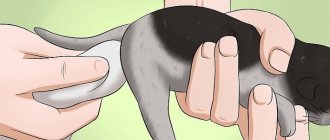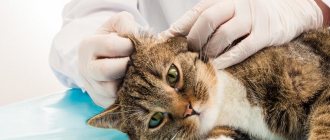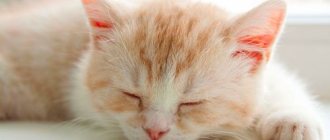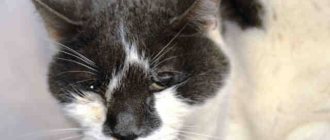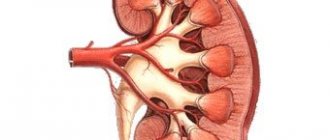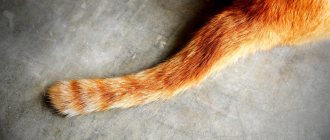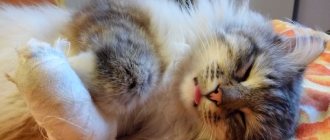Each cat breed has some characteristic feature that distinguishes it from others. Some have huge eyes and a piercing gaze, others have a flattened muzzle and upturned nose, and others have a luxurious fur coat or unusual colors. But among them there are also those who have non-standard ear shapes. Let's find out what these breeds are called and how to properly care for their unusual ears.
Cat breeds with curled ears
There are more than a hundred cat breeds in the world, and only a few of them have a deformed shell. The most famous owners of folded ears are:
- American Curl;
- Scottish fold cat;
- Ukrainian Levkoy.
In addition to the above mentioned breeds, there are several less popular varieties of cats with curled ears, which also deserve attention:
- Highlander;
- elf;
- kinkalow.
Inflammation and perforation of the eardrum: symptoms and treatment
Chronic otitis media can lead to perforation of the eardrum and the development of an inflammatory process in the deep layers of the ear. Symptoms depend on the extent of damage to the septum and whether the inner ear is affected. You can distinguish this problem from others by the following signs:
- the pet often shakes its head and tilts it towards the organ that hurts;
- the animal is poorly oriented in space, walks in circles;
- the affected ear becomes red and swollen, and foul-smelling exudate is released;
- the cat hears poorly, becomes lethargic, refuses food;
- The cat has Horner's syndrome, in which the upper eyelid droops, the pupil narrows, and the eyeball sinks.
The veterinarian begins treatment only after making an accurate diagnosis. Diagnosis includes a visual examination of the affected organ, otoscopy, x-rays, and in some cases CT and MRI. Four-legged patients are usually prescribed antibacterial and antifungal drugs to relieve inflammation in the organ of hearing, and systemic corticosteroids. If the membrane is slightly damaged, it recovers quickly. In more severe situations, surgical intervention is resorted to.
American Curl
This breed of cats with ears bent back appeared in America in the 80s of the last century. Her story began when a couple from California took pity on a stray animal with an unusual appearance. The found cat received the nickname Shulamith and a few months later brought offspring. At first, the owners thought that the kittens did not inherit their mother’s curled ears. But two of them, at 10 days of age, unexpectedly showed this sign. In 1983, cats with ears bent outward caught the eye of specialists, and from that moment serious work began with them. In 1987, the breed received official recognition from TICA.
The American Curl is a medium-sized cat, weighing between 2.5-5 kg. She has expressive almond-shaped eyes, the shade of which matches the color of her coat, and high-set ears, gracefully curved outward at an angle of 90-180 degrees. The harmonious cat's body is covered with short or semi-long hair, which has several color options, including color point, tabby, tortoiseshell, links point, bicolor and solid.
The American Curl is distinguished by its sociable character and high intelligence. A cat with inverted ears is easy to train, quickly becomes attached to people and remains optimistic until old age.
How to understand that a cat is bothered by a sore ear, symptoms
When a pet feels unwell, something hurts, the owner tries in every possible way to help the cat. First, you need to carefully monitor the cat’s behavior so that a more accurate diagnosis can be made. Here are some of the symptoms that indicate ear problems :
- the first sign of illness is the cat’s refusal to eat;
- head jerking. The cat seems to be trying to get rid of a foreign object that has gotten into its ears. He often shakes his head, shakes it, and often scratches his ears with his paw. Many animals try to keep their heads slightly tilted. All this suggests that the cat has ear pain;
- with some diseases, the skin on the inside of the cat’s ear becomes slightly red and may swell;
- black plaque and even scabs may appear in the cat’s ears;
- if external manifestations are invisible, then you need to press on the cat’s ear, which hurts. If you hear a sort of “smacking” sound, and liquid with an unpleasant odor is released from the ear, then the cat has problems with the ears;
- The cat's temperature rises.
© shutterstock
These are all symptoms of ear pain. For some diagnoses, you need to see a doctor, and some problems can be solved yourself. But in both cases, it is necessary to first get advice from a specialist in order to make sure that the problem is identified correctly.
Scottish fold cat
The history of the Scottish Fold began in 1961, when a cat with flattened ears was born on one of the farms. She received the nickname Susie and became the founder of a new breed. Because cats with folded ears are prone to genetic abnormalities and various diseases, they have not been recorded in the UK. The breed was popularized only when American specialists learned about it.
Scottish Folds are medium to large sized cats weighing between 3-8 kg. Their body is covered with short, plush fur with a well-developed undercoat. Representatives of the breed are easily recognized by their rounded heads with full cheeks and large, widely spaced eyes. But the main distinguishing feature of Scottish Folds is their small, forward-curved ears. They must have from 1 to 3 folds. Sometimes the shell fits so tightly to the skull that it seems that the cat is without ears.
Scottish Folds are calm, unobtrusive animals with a gentle and peaceful disposition. They easily adapt to new conditions and quickly become attached to people. Big-eyed cats with folded ears love to take unusual poses and have no problem getting along with children.
A cat has an earache: how to treat it at home
The veterinarian determines the cause of the disease and prescribes treatment.
In the case when Otodectosis (ear scabies, ear mites caused by the parasitism of Otodectos cynotis mites in the ears), caused by an itch mite, is diagnosed, Aurican is prescribed.
This is what an ear mite looks like
This medicine contains the following components:
- diazinon, which has an acaricidal effect;
- prednisolone, which relieves itching and stops inflammation;
- hexamidine is an antibacterial agent;
- Tetracaine is a local anesthetic that relieves pain.
Be sure to read:
The cat has a fever: what to do, reasons, what is the norm, how to bring it down at home, the best methods
When the inflammatory process is complicated by a fungal infection, Surolan is used, which contains the following components:
- miconazole is an antifungal agent;
- prednisolone: anti-inflammatory and antipruritic agent;
- Polymyxin is an antibiotic.
Your veterinarian may prescribe other medications that have similar effects.
If disease of the external auditory canal occurs due to allergic reactions, antihistamines and hypoallergenic veterinary food are used.
Ukrainian Levkoy
These hairless cats, with forward-curved ears, were bred in 2004 thanks to the efforts of Kyiv felinologist Elena Biryukova. To obtain a new breed, the woman used Don Sphynxes and Scottish Folds. As a result of the experiments, unusual, almost hairless kittens with huge eyes and curled ears were born. The new breed was called the “Ukrainian Levkoy” and quickly gained popularity among residents of many countries.
Ukrainian Levkoys are medium-sized hairless cats with well-developed muscles and a stepped profile. A distinctive feature of the breed are small deformed ears with curved tips with one or two horizontal folds and a thin mouse tail.
Ukrainian Levkoys are affectionate and gentle animals with a good-natured and peaceful disposition. Curious and highly intelligent, cats with folded ears are easy to train and try to participate in all household activities.
Ear odor
An offensive odor may be noted even at the initial stage of the disease . This symptomatology is observed with purulent otitis media; in this case, simple anti-inflammatory drops are unlikely to help.
At the same time, among the drugs one can single out such a drug as Anandin, it contains ramicidin C. This substance is active against pathogenic microorganisms. The substance should be instilled 3 drops three times a day.
Features of caring for unusual cats
Cats with curled ears require regular and careful grooming. Their sinks are inspected weekly for unusual discharge and carefully cleaned of dirt and dust. This is done using a cotton pad moistened with a special lotion, being careful not to damage the cartilage.
Otherwise, caring for cats with curled ears is not much different from caring for their regular counterparts. They are also provided with adequate nutrition, preventive veterinary examinations and hygiene procedures.
Cats with curled ears invariably attract attention with their unusual appearance. They all differ from each other in body structure, character and coat type, which is why each of them has its own fans.
Types of ear diseases
Ear diseases in cats are divided into several types:
- damage by microscopic mites - otodectosis;
- otitis;
- ulcers;
- dermatitis;
- hematoma;
- lymphatic extravasate;
- necrosis;
- neoplasms;
- foreign body in the ear canal.
Otodectosis
Another name is ear scabies. This disease is contagious and is quickly transmitted from one animal to another. The tick burrows under the skin and feeds on blood and lymph. Its waste products are dark brown in color. It looks like there are a lot of sticky crumbs in the ear. Otodectosis begins in the outer ear, then moves deeper. Without treatment, it causes complications such as otitis media.
It is impossible to get rid of mites by simply cleaning the ears. Every day after cleaning you need to instill special drops. After 7-10 days, the tick will die, the symptoms will disappear and treatment can be stopped.
Otitis
This is an inflammatory process that can occur for several reasons: as a complication after untreated otodectosis, after water or a foreign object gets into the ear, due to drafts. Infections, injuries, and neoplasms can also be causes of otitis media.
With otitis media, cats often develop a fever and loss of appetite. If ear diseases are complicated by otitis in cats, then you should contact a veterinary clinic as soon as possible for advice and treatment.
Ulcers
Ulcers on the inside of the ear are caused by fungal infections. They look like multiple bubbles that burst after combing. The liquid they contain begins to leak out and causes irritation. The animal itches even more, and after a while the entire inner surface of the ear becomes covered with weeping crusts. Any cat infection that causes ulcers is transmitted from one animal to another.
Before visiting your doctor, you need to blot the sores with a dry sterile bandage and sprinkle with streptocide powder. Ulcers will go away only after a course of antibacterial or antiviral therapy.
Dermatitis
These are also sores, but the main cause is an allergy to food, pet care products or medications. If you identify the exact cause and remove the allergen, the dermatitis will go away on its own. In some cases, ulcers need to be treated with streptocide for several days until they dry completely.
Hematomas
Usually occurs due to injury. Most often this happens in street animals after fights or due to cruelty from people. Outwardly it looks like a bruise or swelling with bruising. This area feels hotter to the touch than the healthy part of the ear. There is blood fluid inside the swelling.
Lymphextravasate
A swelling similar to a hematoma, but lymph accumulates inside.
You can try to remove the hematoma by applying a cold compress in the first 48 hours after the injury, and after the swelling subsides, switch to a warm one. But in no case should you treat lymphatic extravasation in this way; this will lead to complications.
Externally, it is very difficult to distinguish between a hematoma and lymphatic extravasation. Without an accurate diagnosis, you should not apply any compresses so as not to harm your pet.
The same can be said about an abscess. Outwardly, it looks like a hematoma, but inside the swelling there is pus.
Treatment of hematoma and lymphatic extravasation is carried out in a veterinary clinic and involves removing the contents with a syringe. In some cases, it is necessary to open the swelling and cleanse it. In a neglected condition, drainage is done and a course of antibiotics is prescribed.
Necrosis
It happens due to injuries or untreated hematomas and abscesses. In part of the ear, blood circulation is disrupted and the tissue dies. The dead part of the ear is removed surgically.
Neoplasms
They can be different - polyps, fibroids, various tumors. The type of neoplasm and method of treatment can only be determined in a veterinary clinic.
Foreign object
If any object gets into the ear, an experienced veterinarian can easily remove it. After removal, all symptoms cease to bother the animal.
Dirty ears
Dirt in the ear can lead to inflammation.
A cat's sink may contain plant particles, leaves, wax plugs, and sand. This state of affairs most often leads to an inflammatory process .
Help consists of removing the foreign object, washing with a soda solution or hydrogen peroxide solution. The pain is relieved by instillation of camphor oil.
Shell necrosis
Necrosis of the shell can provoke a complication of the purulent process.
Necrosis of the shell can be provoked by the following factors: prolonged pressure on the ear, a complication of a purulent process that has spread from other tissues, the spread of pathogenic microflora due to hematomas or abscesses.
If purulent inflammation is not treated in time, inflammatory foci may open and areas of necrosis of the skin may appear, which leads to thinning of the cartilage. This phenomenon provokes a violation of blood flow , the affected area darkens and an unpleasant smell of rot may appear. The entire ear is deformed.
The only help is surgical – the affected area or the entire organ is removed.
Sores in the shape of a ball
The ear may swell, if there is a small hematoma, the cat could simply get injured. It often happens that an infection gets into the wound and fluid accumulates under the skin.
You can disinfect the affected area ; it is better to entrust these manipulations to a specialist. If the ears are dirty and the animal scratches them until they bleed, then the cause may be various ailments:
- otodectosis,
- allergy,
- purulent otitis media,
- foreign object entering the ear,
- polyps,
- cancerous formations,
- traumatic brain injuries.
If you have purulent discharge, do not delay visiting a specialist. You need to urgently contact a veterinarian. The ear itself may not only hurt, but at the same time there may also be an unpleasant odor from the ears, and the ears may be very itchy. The eyes may also become watery.
If there is an unpleasant smell from the ears, the animal shows too much attention to its ears, then this behavior indicates the presence of otitis media.
What exactly caused this disease can only be said by a specialist. Therefore, you should not postpone a visit to the veterinarian, this will significantly speed up the treatment process. It often happens that to establish a final diagnosis it is necessary to take tests from the animal.
Only with a careful approach will treatment be effective; a specialist can initially only alleviate the suffering of the animal.
Treatment is often prescribed using a fixing bandage, as well as applying ice. After about a day, you can apply warm compresses and treatment with irritating ointments.
If the case is advanced, then the animal will need surgical opening of the hematoma, its cleaning, as well as disinfection measures. The optimal solution would be to use novocaine and antibiotics so that pathogenic microflora does not develop in the future.
Allergic otitis: signs and therapy
Ear inflammation in a cat can be caused by an allergic reaction. It is wrong to think that with allergies, a pet only sniffles, tears flow profusely and sneezes often. The ears are often involved in this process. When mast cells release histamine into the blood, vascular permeability increases, which can lead to changes in the natural microflora of the ear canal. As a result, the organ is attacked by all kinds of pathogenic agents. The affected ear swells, the surrounding tissue becomes watery and red.
A sick pet constantly scratches its ears, which causes scratches and sores to appear on them, and hair falls out. Ignoring these symptoms can lead to the development of a secondary infection, in which the cat begins to secrete exudate from the ear canals. At first it may be serous fluid, but over time pus or dead tissue will appear. At the same time, the animal’s muzzle will swell.
If a four-legged patient is diagnosed with otitis media of allergic etiology, he will be prescribed glucocorticoids (Prednisolone), antifungal and (or) antimicrobial drugs. Antibiotics are used because non-steroidal anti-inflammatory drugs, while stopping allergic reactions, greatly reduce immunity, which is fraught with secondary bacterial or fungal infection.
It is also necessary to regularly clean your pet’s ear canals, freeing them from secretions. For cleaning, special pharmaceutical preparations, warm vegetable oil or Vaseline oil are used. Treatment usually takes 1–1.5 months.

